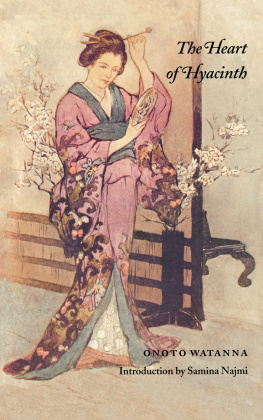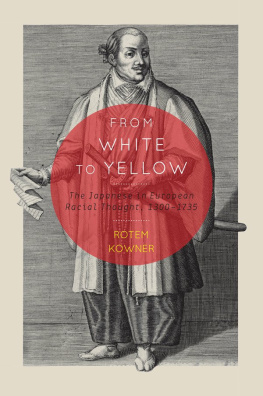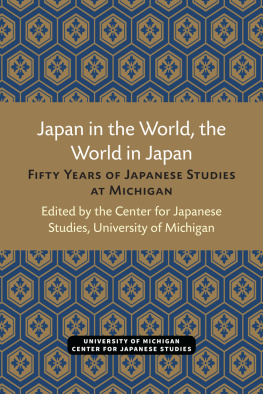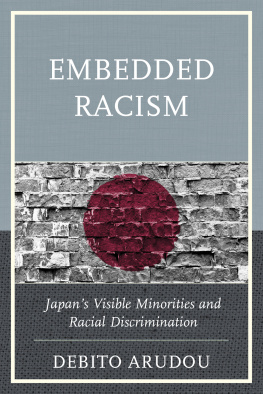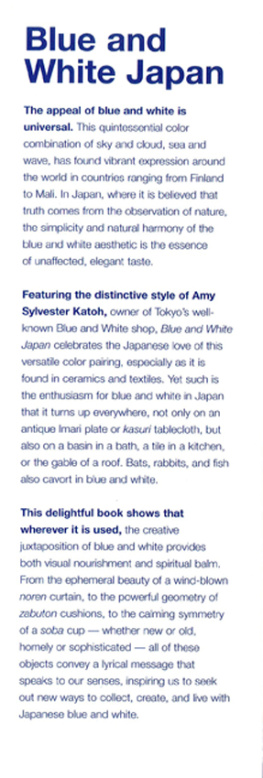
The Heart of Hyacinth
The Heart of Hyacinth
ONOTO WATANNA
Introduction by Samina Najmi
University of Washington Press
SEATTLE AND LONDON
Originally published by Harper & Brothers in 1903.
University of Washington Press paperback edition,
with a new introduction, published in 2000.
Introduction by Samina Najmi copyright 2000
by the University of Washington Press.
All rights reserved.
Library of Congress Cataloging-in-Publication Data
Watanna, Onoto, 18791954.
The heart of Hyacinth / Onoto Watanna ;
introduction by Samina Najmi.
p. cm.
Includes bibliographic references (p. ).
ISBN 0-295-97916-X
1. JapanRace relationsFiction.
2. Young womenJapanFiction.
3. AmericansJapanFiction.
4. Race relationsFiction.
I. Najmi, Samina. II. Title.
PR9199.3.W3689 H422000
813.52DC 21 99-059667
The paper used in this publication is acid-free and recycled from 10 percent post-consumer and at least 50 percent pre-consumer waste. It meets the minimum requirement of American National Standard for Information SciencesPermanence of Paper for Printed Library Materials,
ANSI Z39.481984. 
CONTENTS
INTRODUCTION
WINNIFRED EATON, a woman of Anglo-Chinese ancestry who used the penname Onoto Watanna, wrote at the turn of the twentieth century, a time of intense sinophobia in the United States. Although most Chinese immigrants were seduced from China first by the Gold Rush and then by tales of fabulous employment opportunities on the American transcontinental railroad, once in the United States they found themselves not only doing backbreaking and dangerous work for little pay but discriminated against racially. Myths about the heathen Chinee abounded: on one hand, they were mysterious and unknowable; on the other, they were stereotyped as lagging far behind Caucasians on the evolutionary scale. They were seen by whites as sneaky, dirty, smelly people who wore their hair in queues, ate disgusting things like rats, shrimp, and abalone, devoted themselves to gambling and prostitution, and spread diseases.

Photo credit: Winnifred Eaton Reeve fonds, Special Collections, 299/82.13, University of Calgary Library
the dregs of her population (quoted in See 1995:8; M. Wong 1995:60). Although, as president of the Central Pacific Railroad, Stanford later realized how profitable it was to hire Chinese laborers, his words reflect the mood of the times.
In California, where the Chinese were a visible minority, a series of laws aimed at harassing them specifically forbade ironing after dark, levied taxes on laundrymen who carried clothes on poles, and limited the size of shrimp nets. But the discrimination against them was also codified by federal law. In 1870, the year in which the transcontinental railroad was completed, the Alien Land Act prohibited the ownership of land by the Chinese, among other Asians. Then, in 1882, came the Chinese Exclusion Act, the only immigration act ever to target a specific racial group (M. Wong 1995:62), which barred all Chinese laborers from entering the country. The policy of exclusion thrived until 1943, and during its fifty-year sway other legislative acts (in 1921 and 1924) insured that Chinese wives of American-born Chinese men were also denied entry to the United States. Anti-miscegenation laws existed in most states, making normal family life and population growth in the Chinese community virtually impossible.
Chinese exclusion was thus both economic and sexual, catering to labor fears that the Chinese were taking away jobs that rightfully belonged to white men and to white supremacist fears that Chinese men would marry white women. At Californias constitutional convention in 1878, John F. Miller declared: Were the Chinese to amalgamate at all with our people, it would be the lowest, most vile and degraded of our race, and the result of that amalgamation would be a hybrid of the most despicable, a mongrel of the most detestable that has ever afflicted the earth (quoted in Takaki 1990:101). Californias anti-miscegenation laws remained in effect until 1948. Although many discriminatory laws also affected groups other than the Chinese, nineteenth-century hysteria regarding the
Curiously, however, coexisting with this blatant racial discrimination was a certain fascination for Asia, which has come to be known as Orientalism, after Edward Saids famous book by that name. As Rachel Lee points out in her account of journalistic representations of Asian Americans at the turn of the century (1997), the media perpetuated negative stereotypes of Asians at the same time that they advertised Oriental products as exotic and desirable. Drawing on Saids idea of the domestication of the exotic, Lee makes a provocative argument:
While negative images of the Orient encouraged an American readership to be wary of Asian peoples, the commodification of the Orient into saleable product abated this sense of vulnerability. Thus fear of Asians promoted by journalistic copy resulted not only in vociferous protest against social integration with Asians but also in readerly pleasure at seeing and consuming Asiatic commodities. (1997:25456)
These twin reactions of hatred and exoticization were not targeted evenly at Asian groups. While the Chinese were vilified, in the first quarter of the twentieth century positive Orientalist sensibilities focused mostly on Japan, perhaps from awe of its military might, which had not yet become threatening to the United States. Moreover, the Japanese were not a visible minority in the late nineteenth century. Those who came to the United States quickly adopted Western manners of dress, unlike the Chinese (Kim 1982:125). Hence, according to S. E. Solberg,
The Chinese were commonly perceived as mysterious, evil, nearby, and threatening, while the Japanese were exotic, quaint, delicate (or manly, as the samurai), and distant. The general fascination with the exotic (Japan) was able to transcend racist ideas so long as distance was a part of the formula. (1981:3132)
Even as Chinese Americans and some Japanese Americans were ill treated on the home front, the Orientspecifically, Japanfigured in mainstream Americas imaginings as a mysterious, exotic place: a land of temples and cherry blossoms, peopled by beautiful, glamorous but subservient geisha girls, and heroic samurais who preferred suicidal glory to defeat and dishonor.
Onoto Watanna responded to Americas sinophobia by taking advantage of these Orientalist myths. Instead of either passing as white (as a person with her features could have done) or accepting the Chineseness imposed on someone of her heritage by the dominant culture, she chose not only to pass as a Eurasian of Japanese actually to exploit the Orientalist fantasies of her readership to become a best-selling author.
Born Lillie WinnifredSui Sin Far, Edith Eatons autobiographical essay, Leaves from the Mental Portfolio of a Eurasian (1909), voices the pain and difficulty of growing up half Chinese in North America, even though, despite their keen awareness of their physical difference, the Eatons were not culturally Chinese. Their mother had been raised by English missionaries and the children grew up speaking English at home and were nurtured on Western classics. Most of the Eaton children eventually passed as white.
Artistically inclined, Winnifred felt acutely the privations of poverty in the cramped quarters of her home:
Next page
